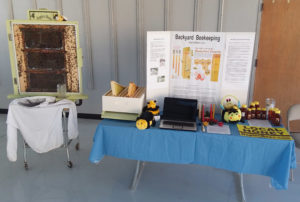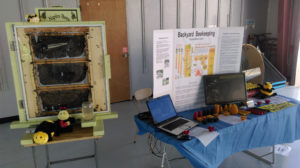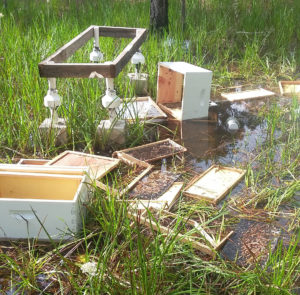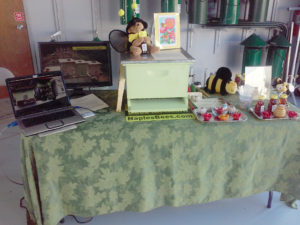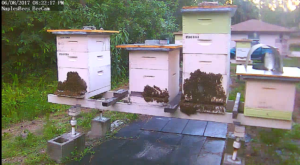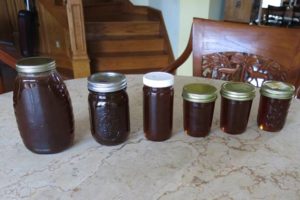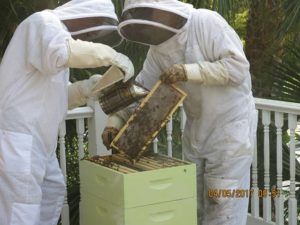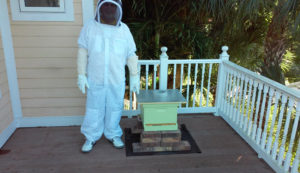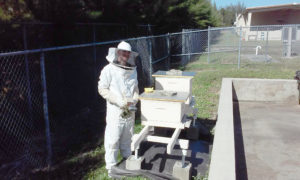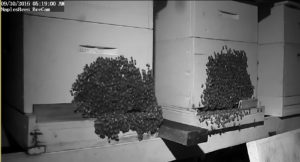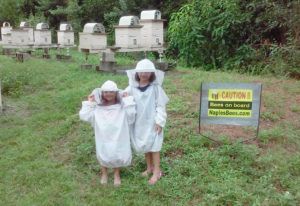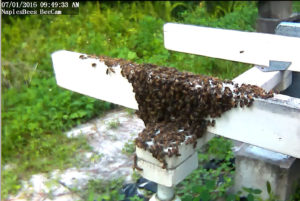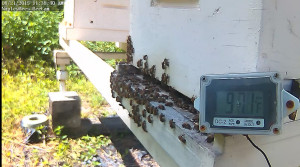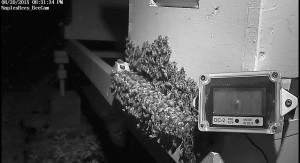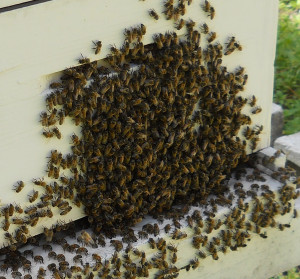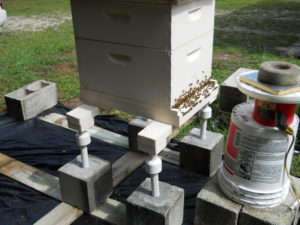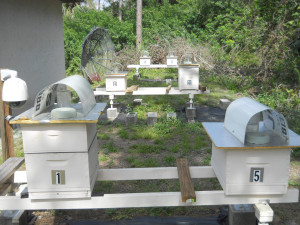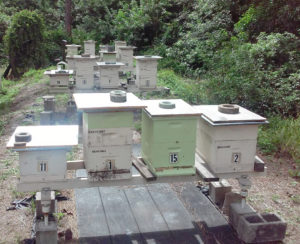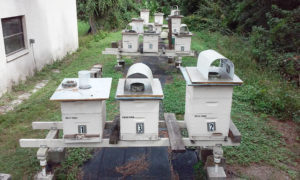WildFlower Apiary
—– Older news about the NaplesBees apiary:
(see Home Page for latest news and activity)
11/7/2019 – We did our third honey harvest of the year. Eight of the hives had a significant amount of fall season capped honey. It is delicious and a beautiful rich light amber color.
10/19/2019 – Bees hanging out on a rainy cloudy day. The foraging bees on the bigger hives are staying put today and “beard” up on the outside of the hive box. If they all went inside, the hive would overheat so they spend time taking turns outside and getting wet.
8/26/2019 – We found a couple huge cane toads in the apiary today. They were apparently catching the occasional bee that flew too close..
7/30/2019 – We did our second honey harvest of the year. As shown in the short video below, care is taken to harvest the absolute best honey which is only “capped” honey …. the honey that has been fully processed by the bees.
7/14/2019 – Getting close to doing another honey harvest. BeeCams show busy July mornings for most of the hives…. visit our LIVE BeeCam page to see what’s happening right now in the NaplesBees apiary.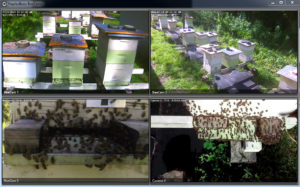
.
6/17, 6/18, 6/19, /2019 – Busy with hive removal activities. See picture details of these removals from a trash can, a copper planter bin and a water meter here.
.
4/1, 5/28, 6/8, 6/12, /2019 – Busy with hive removal activities. See picture details of these removals from a boat, water meters, and a shed here.
.
4/9/2019 – NaplesBees.com donated a “honey basket” to the annual dinner of the Genealogical Society of Collier County .
4/6/2019 – NaplesBees.com had a table at the Collier County Mosquito Control open house at the Naples Airport. The observation hive sparked a lot of conversation about bees and hobby beekeeping!
3/30/2019 – A hive from an oversize water meter was removed. See a picture here.
3/6/2019 – The first honey harvest of the year was done today. This was a little early in the season, but the bees have been very active and a small harvest of 141 pounds was available and put in to one pound and 8oz bottles. Over 7 pounds of wax was collected. Click here to see a short video on how the bees clean up any residual honey from the collected wax comb.
2/2/2019 – There has been a third BeeCam added to the network. This BeeCam number 3 is an experimental camera setup to show a closeup of the entrance of an active hive. What is particularly interesting is an observation of the color and amount of the pollen that is being brought back to the hive. This activity is always a good indication of the health of the hive.
1/22/2019 – We have had some very cool nights (in upper 40s) and I took advantage of a warm afternoon to take a quick look at all 20 hives. All the hives looked full of active bees with the frames in the supers mostly covered with bees. This is a very good sign and shows, so far, the hives are remaining strong going in to the colder months. Many hives have a couple supers of capped honey which the bees don’t seem to have touched yet. I am a happy beekeeper!!
1/2/2019 – A quick look at some of the hives showed all to be in good shape. All the hives have been fairly active at the entrances with the relatively warm weather we have been having.
12/6/2018 – An inspection of the hives in the apiary showed all hives to be active. I estimate there is several hundred pounds of capped honey frames, but that will be left for now in case we get significant cold weather and the bees then might have a need for it.
11/14/2018 – A hive high up in a tree near a guest house was removed. See a few pictures here.
11/6/2018 – Looking to get in to Naples area backyard beekeeping? Check out what NaplesBees can offer here.
10/14/2018 – Large hive removed from a tree behind the NaplesBees apiary and placed in our apiary. See a few pictures and video here.
9/26/2018 – Swarm traps full of bees! More details here .
8/24/2018 – The NaplesBees apiary hives are exploding in numbers. See a few pictures and video here.
7/23/2018 – Today started with a visit from the Florida District 14 Apiary Inspector. Hives in the apiary were inspected for compliance with the Florida regulations for apiaries in the state.
7/11/2018 – I completed the second honey harvest for the year. I was able to harvest from about 7 of the larger hives and the result was 275 pounds of honey.
7/3/2018 – Bees in a bird house were removed from an East Naples location here.
6/26/2018 – A small hive was removed from a water meter box here .
5/4/2018 – I completed the first honey harvest of the year. This harvest resulted in about 305 pounds of honey which ended up in 1 pound, 12oz, and 8oz bottles. This is the biggest harvest I have every had and could not have been done without the use of the motorized honeycomb press I had made.
4/28/2018 – The NaplesBees table at the Collier Mosquito Control District open house was a good success with lots of interest in the observation hive. The queen was found (with help) many times as she was observed busy laying eggs.
4/6/2018 – A second BeeCam was brought online today. It gives a overhead and more complete view of the apiary. Check it out on the BeeCam page.
4/3/2018 — Bad news and good news…. A few weeks ago I noticed several of our recent hive removal boxes (3/15/2018 and 3/2/2018) were queenless and nad no brood. To save these colonies, we tried introducing a few mature queen cells in to each of these hives. They apparently successfully hatched and the queens have been accepted because today’s inspection found a queen running around in each hive. Hopefully these queens will survive going forward and grow the hives.
3/15/2018 — A swarm removed from a cypress tree branch here.
3/3/2018 — A homemade observation hive has been built here.
3/2/2018 — A large hive was removed from a house outside wall here.
1/26/2018 — A large hive was removed from a shed wall here.
1/2/2018 — Cooler temperatures have forced the bees into a low activity mode. Relatively few bees are venturing out for foraging.
|
12/1/2017 — Because of airport management policy changes, today we relocated our two remaining hurricane damaged hives at the Naples Airport back to our home NaplesBees apiary. The bees had survived hurricane Irma but they were knocked over onto the ground and had a few ant problems. We cleaned them up best we could and gave them good spots on apiary stands, so, hopefully, they will get their numbers back up. 11/1/2017 — The NaplesBees apiary is back in good condition as hurricane Irma cleanup and repairs continue. See an aerial video view here.
8/21/2017 — A birdhouse occupied by bees was removed here. 8/17/2017 — Here is a picture of hives belonging to a hobby beekeeper in eastern Golden Gate estates after a visit by something large enough to be very destructive….bears? 8/12/2017 — Completion of the much more robust and improved home made honey comb press here . 7/21/2017 — A good size honey harvest from our Golden Gate estates apiary hives here . 7/14/2017 — A small honey harvest from our Naples Airport hives here . 6/21/2017 — A small hive built on a bicycle handle was removed here. 6/24/2017 — NaplesBees had a table display at the Collier Mosquito Control Headquarters open house. Sample tasting of our honey was available and we talked to many people about CMCD and area bees, especially the terrific aerial spray notification system they have available now which is a great tool for local beekeepers or anyone interested in their mosquito spraying operation. We cover up our hives for a few hours if any spray planes are due to come over in order to better protect the bearding bees from any possible injury. 6/21/2017 — An abandoned hive on a vacant lot was removed here. 6/8/2017 — The nectar flow is on!! Bee hive populations have exploded and our apiary hives are very busy. This is a view of the bearding that is evident in the warm summer evenings. 6/3/2017 — We removed a small hive from concrete blocks located in a backyard of an East Naples home here. 5/26/2017 — An attempt to remove an older hive from a roof without roof destruction here. 5/23/2017 — I improved our homemade honey press here. 5/9/2017 — The apiary’s second honey harvest of the year collected 90 pounds of delicious rich, viscous, dark amber honey here. It took two days to harvest, process and bottle. 4/19/2017 — A small size hive was removed from a water meter here. 4/12/2017 — A medium size hive was removed from a palm tree here. 4/12/2017 — UPDATE on the 2/25/2017 and 4/5/2017 entries described below, The “second story porch” beekeeper that obtained one of our hives a few months ago has done his very first honey harvest which was 4 of the full super’s capped frames we observed on the 4/5/2017 inspection. It is exciting to see the bottles of dark, rich, and sweet honey!! It is proof of what can happen when you are a good beekeeper with healthy, happy bees that have lots of flora to forage. Outstanding accomplishment!! 4/11/2017 — For the Genealogical Society of Collier County annual dinner meeting, NaplesBees donated a “honey basket” to be one of their free raffle gifts. It included three bottles of our honey and multiple kinds of our beeswax candles. 4/7/2017 — An inspection was done of the hives located at the Collier County Mosquito Control District Headquarters located at the Naples airport. One hive never seemed to grow since day one, but the other one is an overachiever!! See details and photos here. 4/5/2017 — UPDATE on the 2/25/2017 entry described below. We again inspected the hive and all was good. The bees had almost filled the super we put on last month with honey and were in need of the additional space of another super which we added. The “holy grail” of many full frames of capped honey is near. The homeowner beekeeper has decided to add a second hive on the second floor deck shortly. 3/24/2017 — A small hive in a street side water meter was removed here. 3/17/2017 — A medium size hive located in a tree near a house in Golden Gate Estates was removed here. 3/1/2017 — A small hive under the roof overhang of a house located off the Immokalee Road in North Naples was removed here. 2/25/2017 — UPDATE on the 1/20/2017 entry described below. We helped with the new beekeeper’s first inspection of his new hive that was obtained from our apiary. The gentle bees are doing great, almost completely filling the brood box with brood/pollen/honey and necessitating the immediate addition of a super to give them more space. The south Naples location has an abundance of flora and the second story deck location seems to suit the bees well. 2/24/2017 — Our first honey harvest of the year collected 42 pounds of delicious rich golden colored honey here. It is always hard work, but rewarding. 2/17/2017 — We did an inspection of our two hives located at the Naples airport CMCD. The smaller hive is not doing too well. The queen in that hive does not seem very mature and is not producing very much brood. The larger hive was doing well with lots of bees and activity. It was necessary to add another super to that hive to keep them from running out of space. 2/3/2017 — A very small hive was removed from a water meter box located at a North Naples residence here. After a week in our apiary, this one is turning out to be an adventure in unusual activity…. 1/25/2017 and 1/27/2017 — Hives were removed from two water meter boxes located at a Naples area church here. 1/20/2017 — Think you don’t have a place to keep bees and become a hobby beekeeper? Think again ! Today we moved one of our apiary established hives to a second story porch of a house located in beautiful south Naples. The Internet is full of stories of city dwellers keeping bees on the roof of high rises, so why not keep bees on your second story porch? We will see how the hive does, but the surrounding area has miles of gorgeous flora which should provide ample nectar and pollen for the bee foragers.
1/3/2017 — Small hive removed from a flower pot here. 12/9/2016 — We did another monthly inspection of our Naples Airport Mosquito Control District headquarters located hives. Both hives are doing well with the larger hive’s super 75% filled with capped honey. Next month’s inspection may necessitate adding an additional super. 12/3/2016 — Medium size hive removed from a cabinet in an outdoor kitchen located behind a Golden Gate house here. 11/11/2016 — Medium size hive removed from a water meter here. 11/9/2016 — The two hives we relocated from our apiary to the Naples Airport Collier Mosquito Control District headquarters on 9/30/2016 were inspected today. I was assisted by the onsite beekeeper, Mark, in opening each hive and assessing the condition. We were delighted to find each hive doing well, with the more advanced hive having several frames of capped or nearly all capped honey in its super. Apparently the bees survived the relocation from our apiary with no issues and are thriving in their new surroundings. We will be doing periodic checks going forward with anticipation of some day being rewarded with the area’s “black mangrove” honey !! 11/2/2016 — Yet another medium size hive removed from side of a house here. 10/12/2016 — Medium size hive removed from side of a house here. 10/5/2016 — 30 pounds of honey was harvested from various apiary hives. 10/3/2016 — This afternoon we euthanized another of our hives that was extremely aggressive when it was approached for a closer look because it might be getting ready to swarm. Without even disturbing the hive, the bees went defensive, indicating the high probably of Africanized genetics. 9/30/2016 — Early this morning, we moved two of our hives to a Naples Airport location almost exactly 3 miles away as the bee flies (5.1 miles driving). Stay tuned for more information in the following weeks for pictures and details as to how they are doing. 9/30/2016 — Awesome picture of bearding on a couple of our hives in the early morning hours (snapshot from our BeeCam): 9/17/2016 — Medium size hive removed from a water fountain here. 9/14/2016 — Small hive removed from a water meter here. 9/11/2016 — Today we had a couple exuberant visitors. The girls tried on bee suits and then took a walk into our apiary to see the hives up close. It was an exciting time learning all about the bees and how they live and make the honey and wax. Look out Mom and Dad …… in a few years they might want a hive of their own in the backyard !! 9/3/2016 — Small hive removed from a window alcove here. 8/31/2016 — One of our larger hives was euthanized today. When we removed the hive from a compost bin (Removal 5) back in 3/11/2016 they were thought to be OK, but may have been more aggressive than what we normally see. Sometimes aggressiveness is hard to judge on a removal because, after all, you are dismantling their house and no bees are ever happy with that. However, our last honey harvest (8/3/2016) that involved this hive revealed the bees were overly aggressive and were attacking my suit and gloves by the hundreds. Good beekeeping means keeping good bees (non Africanized genetics). The decision was made at that point to euthanize the colony. Requeening was not an option we wanted to do in this case. Today, with a bin of soapy water and spraying with soapy water solution the hive was destroyed without any chemicals. Although necessary, it was sad to do as it was a very large hive (probably 30-40K bees) and a honey producer. 8/26/2016 — Small hive removed here. 8/19/2016 — Small hive removed here. 8/3/2016 — 56 pounds of honey was harvested from four of our hives. 7/27/2016 — We removed another very large hive underneath a mobile home in East Naples. 7/24/2016 — We removed a very large hive on the side of a home in Bonita Springs. 7/5/2016 — Apiary bees are looking busy. 7/1/2016 — We did another inspection of most of the hives in our apiary. Some hives have a lot of honey but not all was capped yet. We added more supers. 6/17/2016 — We did a quick inspection of most of the hives in our apiary. Hives #2 and #7 showed their super(s) were about maxed out so an additional super was added to each. We expect to be able to harvest some honey in another couple weeks. 6/5/2016 – We did a difficult removal of a medium size hive from a concrete block wall in the Lakewood area. 6/3/2016 – We removed a good size hive from the wall of an old construction trailer in Golden Gate Estates. It involved cutting away the interior wall to access the long combs which were then cut up to fit into multiple deep frames. 5/31/2016 – We removed a Naples area small hive located in a water meter. The hive was fairly gentle and the queen was captured. Interestingly, we almost gave up on finding the queen because she was not found to be on any of the removed comb. Instead she was found hiding under a small screwed down plastic compartment on the underside of the water meter lid…….. amazing!! We’ll be placing the hive in our apiary in the coming days. 5/28/2016 – Hive #6, a small swarm capture, had been abandoned. Even though comb with eggs was added recently, this hive just didn’t seem to be able to make it. Abandoned comb was very clean. BeeCam night vision repaired today. 5/14/2016 – We did an unplanned small honey harvest. 5/13/2016 – We are down to 9 hives in the apiary. Details here. 4/30/2016 – We removed a small swarm hive from a water meter. 4/23/2016 – We removed a small swarm hive from a flower pot. 4/22/2016 – Hive # 6 hive didn’t make it. This was the hive that was originally from Swarm Catch–7, which was very small and subsequently added to with Swarm Catch-9 . It was always iffy because of the very small number of total bees. Our remaining nuc (caught from a swarm from Hive #9) and Hive #3 (from Swarm Catch-10 ) both have multiple queen cups that should be hatching soon. 4/16/2016 – We removed a large hive from a gazebo and relocated it to our apiary. See the pictures here. 4/8/2016 – Wildflower Apiary is booming. Between the hive removals/relocations done recently (see immediately below) and a hive swarm catch a few days ago from one of our older established hives, the apiary is up to 8 hives and the new hives and older hives are all doing well. 3/21/2016 – We have a few new hives started after recovering three swarms as detailed here and here and here. It’s too early to tell how they will turn out, but they both transported well and seemed to have settled in well to their new location. 2/29/2016 – A newly acquired “ventilated” bee suit hopefully offers some relief to the hot southwest Florida bee yard work this summer. 12/19/2015 – Playing around with candle making. 11/22/2015 – We completed our bee vac project 11/17/2015 – We got an email from John in Marco Island concerning a couple hives in a tree on the side of his house. We took a look at the situation and were able to remove one of the hives. More details and progress here. 11/15/2015 – We have lost another hive. Hive #6 population had gone way down and has no brood or queen. Wax moths have started to take hold. The swarm capture below did not survive either, as I don’t think it ever had a queen. We are currently down to 3 hives……. beekeeping is not always easy! 10/31/2015 – We had quite a a swarm adventure on Saturday as our biggest hive decided to produce a small swarm. We chased it for a few hours and ended up with a surprising result. 10/14/2015 – On a recent small honey harvest, we tried a new homemade honeycomb press for the first time. It is a great tool for the job and well worth the time and effort to make. Click here for details and pictures. 10/3/2015 – Ever wondered how they do it? Check out Victoria’s project making lip balm from some recently gathered beeswax. She said it is not easy to make, but the end product turned out to be fantastic. 9/7/2015 – Hive #9 inspection showed it had a large mature looking queen. Since no queen cups were seen and this queen was too mature to have come from the egg/larva frame added on 9/2/2015 (see below), it must have been there previously and missed on those inspections. Having a queen that we missed in past inspections would also explain why we saw no queen cells built. 9/2/2015 – Hive #9 is continuing to be a problem with getting a good queen established. Today, we made yet another attempt by again taking a frame of eggs/larva from hive #7 (a successfully self queened hive) and placing into hive #9. This is about the fifth attempt. Previous tries have resulted in either no queen or very immature (or poorly mated) queens that just did not produce any brood. On another note…… the overall honey production by all hives is way down this year because of the very wet weather. In fact, published reports indicate Florida and South Georgia will probably end up this season with an extremely low honey crop. The only good aspect to this is that I am now reasonably sure that our lack of honey this year is not due to something we are doing wrong. 8/13/2015 – An inspection about 6 days ago showed hive #9 had lost its queen (which had been marked but did seem rather small and possibly not well mated), so a few frames of eggs/larva/brood from hive #4 were placed in it. Today’s inspection showed about 7 capped queen cells. Cages were placed around two of the queen cells. |
| 8/4/2015 – Hive #9 now has a marked queen and appears to have been accepted. We’ve made a short video of the new queens in the new hives #7 and #9 and can be seen on this link: New Queens. |
|
Above top two pictures are day and night pictures of the front entrance beecam still shots of hive #7 — that is one of the new hives made from a split. The digital thermometer shows the brood box temperature. Click on the picture for a larger view. The third picture is just a fun shot of hive #4 hanging out on a sunny afternoon. |
| 7/24/2015 – Hive #9 inspection showed all the queen cells have hatched but no sign of a queen except for the one cell I had caged. It has an active queen confined. We are expecting bad weather for the next few days, so she will remain confined for a while before deciding to release her in this hive or make a new nuc. |
| 7/22/2015 – Hive #7 still has a good looking queen, so this may be a successful split. The hive is full of bees, so I may need to add a super to it on the next visit. Hive #9 still has capped queen cells that are due to hatch this week. We repositioned the beecam to watch hive #7 and also added a digital thermometer to show the core brood box temperature, which healthy bees will keep around 96 F regardless of the outside temperature. |
| 7/18/2015 – Hive #7 inspection revealed it has a good looking queen. Let’s hope she decides to stay at home this time (third attempt on this hive to raise a queen). Hive #9 has multiple queen cells, one of which I put a cage around and two more that are uncaged. When they hatch, the cage will prevent the fact that the first hatched tries to kill all the other potential queens. Perhaps we will be able to use the caged queen to make another nuc. |
| 7/9/2015 – We took a couple frames out of hive #4 today and put them into hive #9, which is the hive described here where the bees just vanished. It will be interesting to see what happens with this queenless hive. |
| 7/8/2015 – We took a frame of brood/eggs out of hive #1 on 7/4/2015 and placed into hive #7 in an attempt to get them to make a queen. Today’s inspection showed three or four nicely developing queen cells on the bottom of a frame. Maybe the third attempt will succeed !! |
| 7/1/2015 – We were asked to take a look at a hive that established itself in an upside down flower pot located near a storage shed. See the details of moving this nice hive here and the end result in only a day, along with more continuing updates posted. |
| 5/28 – 5/29/2015 – Hive #5 was not going very well with no larva/brood/queen. It was combined into hive #7 with a couple frames of eggs/brood from hive #4 which was very strong and reaching its brood box limit. The saga of the purchased queens has not gone well considering 3 or the 4 hives created with the new queens did not seem to be able to survive. |
| 5/15/2015 – An inspection of hives showed #7 and #8 to be queenless and no brood/larva/eggs. Both the hives had weak population. #8 was combined with #7 and a frame of brood/larva/eggs from hive #6 was added. We will see if they are able to make a new queen and survive. It is possible that the 4/29/2015 storm that damaged the hives is the root cause of this problem as these two hives were the weakest and newest splits. |
| 4/29/2015 – A storm front blew through here at 3:30 AM causing some damage to our hives. Winds were reminiscent of past hurricane speed winds with the pine trees bending way over. All the brick held down shade tops and sugar syrup feed bottles were blown off, but the hives stayed intact except for water getting in from the bottle cutouts. A 4 AM temporary repair helped and in the later morning things were put back in order with the bees slowly recovering………. whew…… it could have been a lot worse !! |
| 4/25/2015 – Inspection revealed all the 4/21 inserted queen cages into hives #5,6,7, and 8 have been opened by the bees and have queens roaming through the frames. This is a very good sign for going forward into spring. |
| 4/22/2015 – Hive #1 has a queen! Where it came from is a mystery, but I must have missed it with last month’s and recent weeks inspections (detailed below). Also 4 new Italian queens were obtained from carpentersapiaries.com and have been placed into new hives that were built from frames from hive #1 and hive #4. The new hives are now known as hives #5,6,7, and 8 |
| 7/1/2014 – A picture of the experimental “anti ant” pvc/cement block posts stand that eventually went on to be incorporated in the design for all of our apiary hive stands.
|
| Various views of the NaplesBees apiary over the years: |
| Apiary view in April 2015 (click on picture for larger view) |
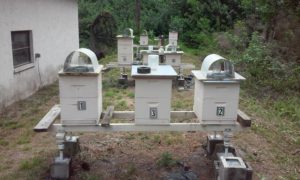 |
| Apiary view in April 2016 (click on picture for larger view) |
|
|


